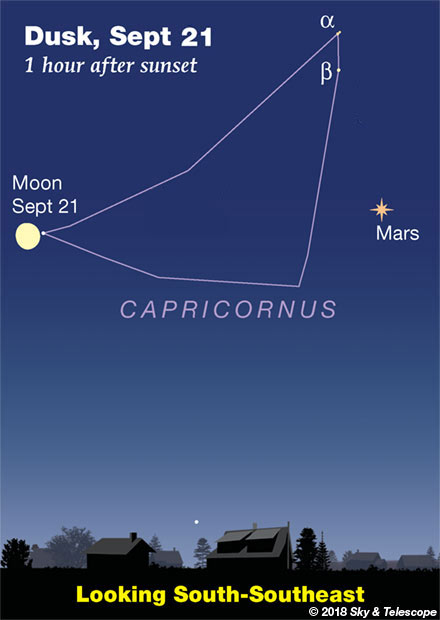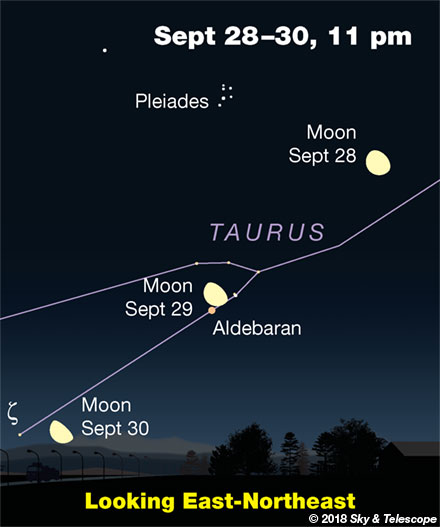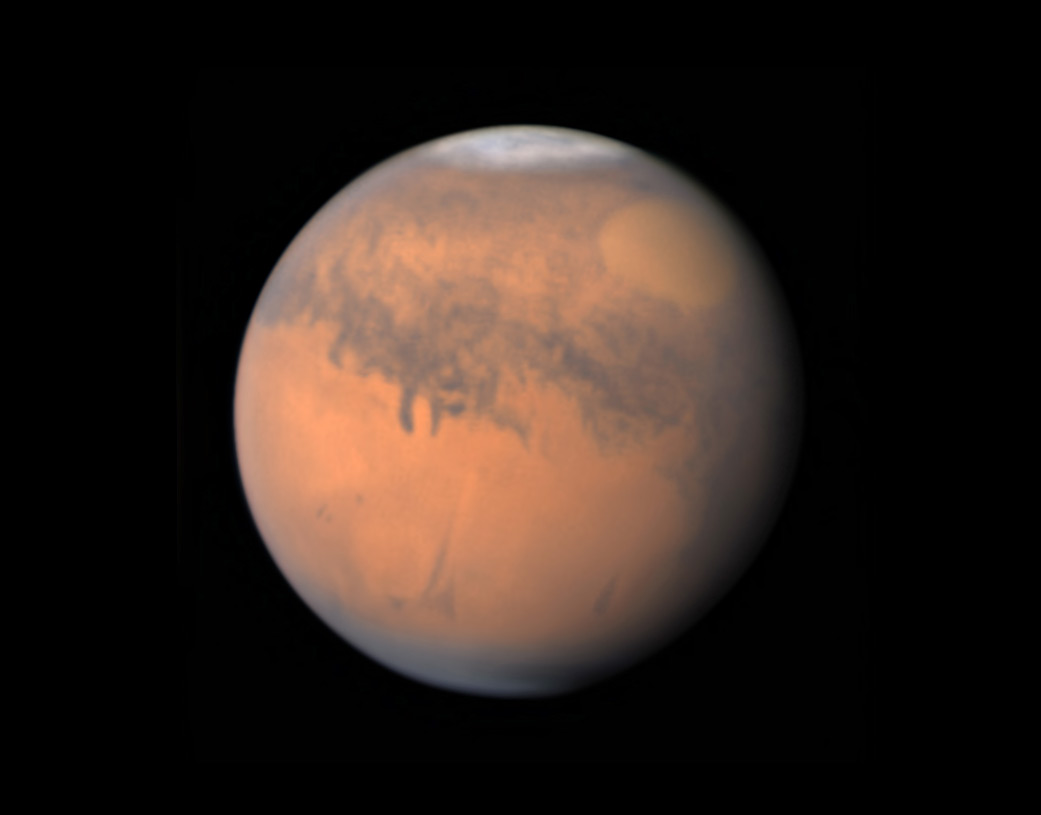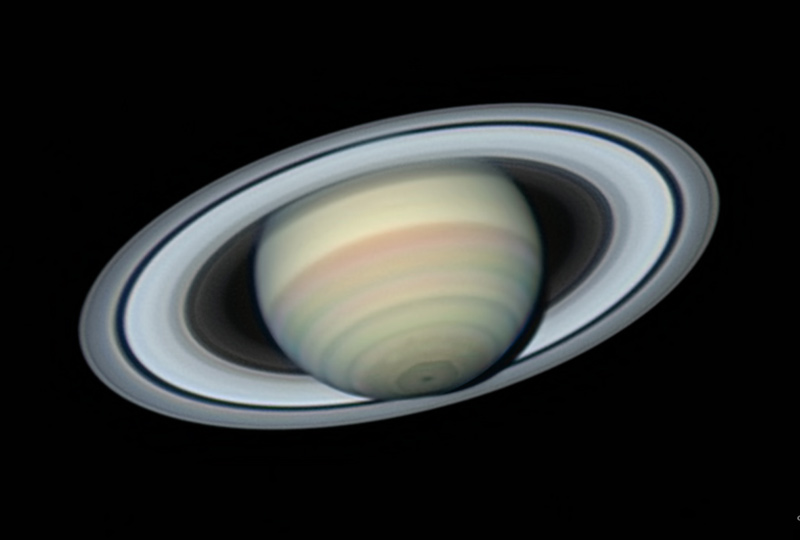
Friday, September 21
• Mars shines well to the right of the waxing gibbous Moon this evening, as shown here. Between them lies dim, boat-shaped Capricornus — or as I sometimes see it in a dark sky, a huge, smiling clown mouth gaping down at the world. It's 20° from end to end: two fists at arm's length, or three or four binocular fields of view.
• Around the closing days of summer (the equinox is tomorrow), you always find the Sagittarius Teapot moving to the right of south during evening and tipping increasingly far over to the right, as if pouring out summer's end.
Saturday, September 22
• The September equinox occurs at 9:54 p.m. Eastern Daylight Time, when the Sun crosses the equator heading south for the season. This moment marks the beginning of autumn in the Northern Hemisphere, spring in the Southern Hemisphere. And the Sun rises and sets almost exactly east and west.
• Also around when summer turns to autumn, Deneb takes over from Vega as the zenith star after nightfall (for skywatchers at mid-northern latitudes).
• After dark tonight, the Great Square of Pegasus balances on one corner about three fists at arm's length to the left or upper left of the gibbous Moon. The Square's upper right side points down more or less toward the Moon.
Sunday, September 23
• Now the Moon shines even farther left of Mars after dark. Look lower right of the Moon, by roughly half that distance, for Fomalhaut, the Autumn Star, low and slowly on its way up in the southeast.
Monday, September 24
• Full Moon (exact at 10:52 p.m. EDT). The Moon rises in the east soon after sunset. Later in the evening you'll find the Great Square of Pegasus above it by a couple of fists at arm's length.
Tuesday, September 25
• A week ago, Altair stood straight above Mars after nightfall. Now Altair is moving a little to the right of straight above Mars as seen at this time.
Why? Stars high in the south appear to move west faster than stars low in the south (for those of us in the mid-northern latitudes). Moreover, Mars is now moving eastward (leftward) against the stars behind it — faster every week.
Wednesday, September 26
• As the stars come out in late twilight, Cassiopeia is already higher in the northeast now than the sinking Big Dipper is in the northwest. You'll find Cassiopeia's broad W pattern almost standing on end.
Thursday, September 27
• Arcturus shines ever lower in the west-northwest after dark. The narrow kite shape of its constellation, Bootes, extends two fists at arm's length to Arcturus's upper right; Arcturus is where the tail would be tied on.
• To the right of Bootes, the Big Dipper is now turning more level.
• And during evening at this time of year, the dim Little Dipper "dumps water" into the bowl of the Big Dipper way down below it. The Big Dipper will dump it back in the evenings of spring.

Friday, September 28
• Late this evening, spot the Pleiades upper left of the Moon as shown here. When the Pleiades climb the eastern sky in autumn, we see their tiny dipper pattern standing on its handle.
Saturday, September 29
• There's roughly a two-hour window of darkness now between twilight's end and moonrise (for the world's mid-northern latitudes). The window gets longer every night this week. Take the opportunity to work through Jerry Oltion's "Tourist Guide to the Autumn Highlights" for small scopes in the October Sky & Telescope, page 28.
• Late tonight when the Moon does rise, it's in company with Aldebaran — though not necessarily quite as shown here, for the reasons in the caption at the top of this page.
By Sunday morning the 30th, the Moon and Aldebaran are shining very high toward the south.
________________________
Want to become a better astronomer? Learn your way around the constellations! They're the key to locating everything fainter and deeper to hunt with binoculars or a telescope.
This is an outdoor nature hobby. For an easy-to-use constellation guide covering the whole evening sky, use the big monthly map in the center of each issue of Sky & Telescope, the essential guide to astronomy.

Once you get a telescope, to put it to good use you'll need a detailed, large-scale sky atlas (set of charts). The basic standard is the Pocket Sky Atlas (in either the original or Jumbo Edition), which shows stars to magnitude 7.6.
Next up is the larger and deeper Sky Atlas 2000.0, plotting stars to magnitude 8.5; nearly three times as many. The next up, once you know your way around, are the even larger Interstellarum atlas (stars to magnitude 9.5) and Uranometria 2000.0 (stars to magnitude 9.75). And read how to use sky charts with a telescope.
You'll also want a good deep-sky guidebook, such as Sue French's Deep-Sky Wonders collection (which includes its own charts), Sky Atlas 2000.0 Companion by Strong and Sinnott, or the bigger Night Sky Observer's Guide by Kepple and Sanner.
Can a computerized telescope replace charts? Not for beginners, I don't think, and not on mounts and tripods that are less than top-quality mechanically (meaning heavy and expensive). And as Terence Dickinson and Alan Dyer say in their Backyard Astronomer's Guide, "A full appreciation of the universe cannot come without developing the skills to find things in the sky and understanding how the sky works. This knowledge comes only by spending time under the stars with star maps in hand."
This Week's Planet Roundup


Mercury is hidden in the glare of the Sun.
Venus (magnitude –4.8, at its peak brilliancy) shines very low in the west-southwest after sunset. It sets in late twilight. Don't confuse it with Jupiter, which will probably catch your eye first. Venus is down to Jupiter's lower right. Their separation remains steady this week at 14°.
In a telescope Venus is an increasingly striking crescent, about 25% sunlit now and 41 arcseconds tall. For better telescopic seeing, catch Venus higher in a blue sky long before sunset.
Mars, in southern Capricornus, fades from magnitude –1.5 to –1.3 this week, still as bright as Sirius. It shines highest in the south soon after dark and sets around 2 a.m.
In a telescope Mars is about 17 arcseconds wide. For a Mars map that displays which side is facing Earth at your time and date, use our Mars Profiler.
Jupiter (magnitude –1.8, in Libra) shines ever lower in the southwest in twilight, upper left of Venus.
Saturn (magnitude +0.5, above the spout-tip of the Sagittarius Teapot) glows pale yellow in the south-southwest at dusk. It's about three fists at arm's length to the right of brighter Mars.
Uranus, near the Aries-Pisces border, is easy in binoculars at magnitude 5.7 — if you have a finder chart and know the constellations well enough to see where to start with it.
Neptune, in Aquarius, is harder at magnitude 7.8. By late evening both are well up in the east and southeast, respectively. Finder charts for Uranus and Neptune, or see the September Sky & Telescope, page 48.
______________________
All descriptions that relate to your horizon — including the words up, down, right, and left — are written for the world's mid-northern latitudes. Descriptions that also depend on longitude (mainly Moon positions) are for North America.
Eastern Daylight Time (EDT) is Universal Time (also called UT, UTC, GMT, or Z time) minus 4 hours.
______________________
"Remember to look up at the stars and not down at your feet. Try to make sense of what you see and wonder about what makes the universe exist. Be curious."
— Stephen Hawking, 1942–2018
______________________
"The dangers of not thinking clearly are much greater now than ever before. It's not that there's something new in our way of thinking, it's that credulous and confused thinking can be much more lethal in ways it was never before."
— Carl Sagan, 1996
______________________
"Objective reality exists. Facts are often determinable. Vaccines save lives. Carbon dioxide warms the globe. Bacteria evolve to thwart antibiotics, because evolution. Science and reason are not a liberal conspiracy. They are how we determine facts. Civilization's survival depends on our ability, and willingness, to do this."
— Alan MacRobert, your Sky at a Glance editor
______________________
"Facts are stubborn things."
— John Adams, 1770
 0
0








Comments
You must be logged in to post a comment.